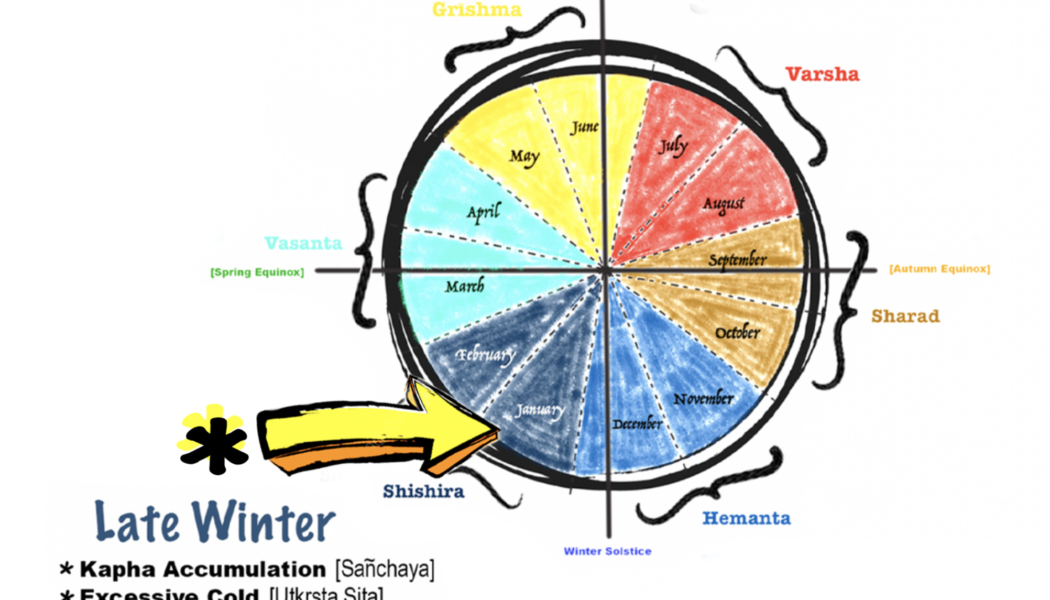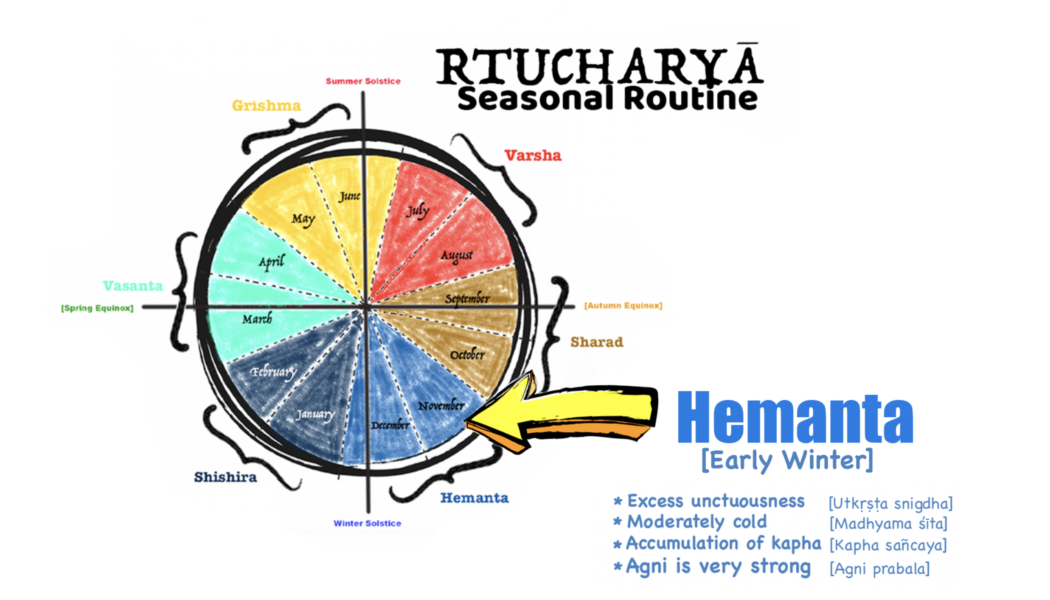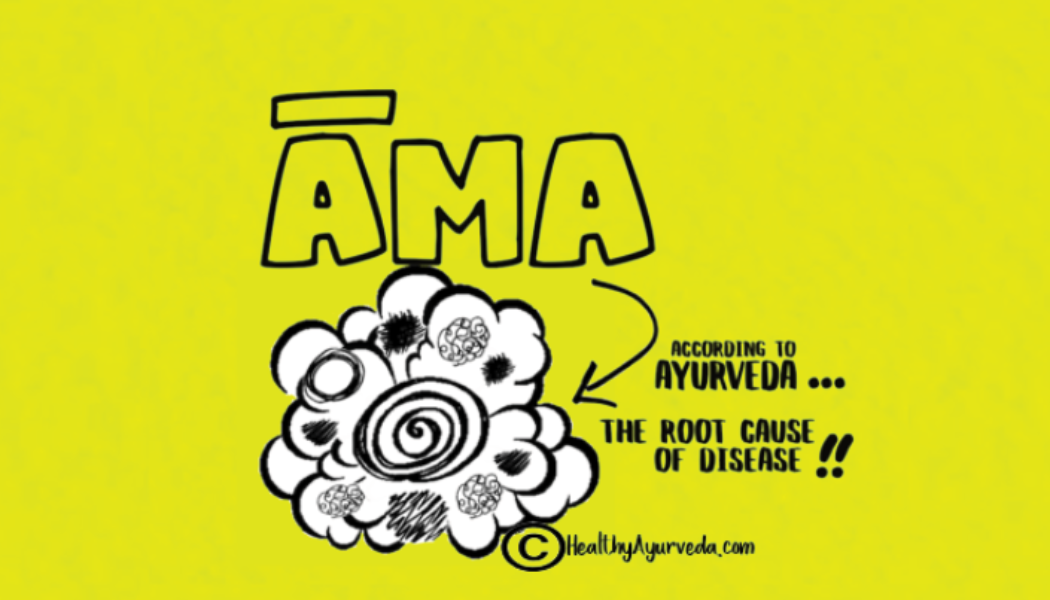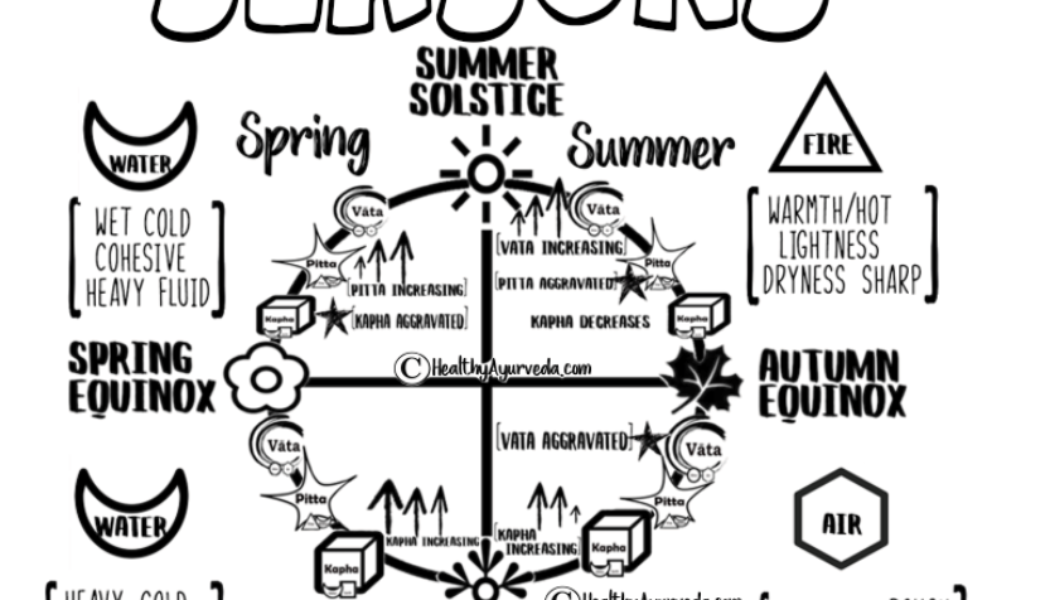Resource Guide - Healthy Ayurveda
Ayurveda Guide For Spring Season [Vasanta]
Ayurveda Guide For Spring Season Spring is a time of new beginnings. This is a time when nature comes to life. This is a time when it begins to warm from the freezing cold of the previous winter. Ayurveda explains that “accumulated kapha” from late winter which solidified due to extreme cold now begins to liquefy by the warmth of spring which, consequently decreases Agni — which then, may cause various digestive conditions along with other numerous health conditions. This can be likened to the snow which develops upon mountain tops. As the snow melts, this floods the valley below. Similarly, kapha which developed and solidified due to the extreme cold of winter now begins to melt and begins to flood various regions of the body. This tends to impair digestion and manife...
Ayurveda Guide For Late Winter Season
Ayurveda Guide For Late Winter Season Ayurveda explains that whatever there is within the environment is also there within the human body and that such changes within the environment have an influence upon the body. During this time of year, the qualities of nature become excessively cold & excessively dry and therefore influence the body as such. Essentially, keep doing what you’re doing BUT more so … Meaning, it’s advised to continue the same regimen of early winter during late winter. For example, having meat soup prepared from well-nourished animals with the addition of fat; such as ghee. Having alcoholic drinks made from jaggery and consuming other food made of wheat, black gram, sugarcane and milk products are ideal during winter season. It’s also...
Ayurveda Guidelines for Early Winter Season
Early Winter Season Hemanta [early winter] is a pleasant transition from the excess dryness of autumn. Hemanta provides unctuous & cold qualities into the atmosphere. “Whatever there is in the environment is also there in the human body” The Sanskrit word “Rtu” means the seasonal movement of time, while “Charyā” means routine or lifestyle. Therefore, ‘Rtucharyā’ means a seasonal routine or seasonal lifestyle. – Dr. Vasant Lad During this time of the year [i.e.Visarga Kāla] it’s hydrating as the power of the Sun becomes less … and the gentle qualities of the moon become more predominant. The qualities of early winter [hemanta] are excessively unctuous [utkrsta snigdha] and moderately cold [madhyama śīta]. Increased Agni = Increased Hunger & Appetite Very St...
Digestion According To Ayurveda
Disclaimer: All content included on this website (including, but not limited to, images, photos, graphics and text) is the property of ‘Healthy Ayurveda’ and ‘Vedic Sage’ and as such is protected by US and international copyright and other intellectual property laws. Digestion According To Ayurveda The fundamentals of Ayurveda is centered around digestion and takes into consideration: Rasa: the 6 differing tastes … which are sweet, sour, salty, pungent, bitter and astringent Virya: the potency or power contained within food and/or medicine Vipaka: the influence of food at the tissue level once digestion within the GI tract is complete Prabhava … which will be discussed further in another post According To Ayurveda … Every substance is ...
Ama ~ The Root Cause Of Disease According To Ayurveda
Disclaimer: All content included on this website (including, but not limited to, images, photos, graphics and text) is the property of ‘Healthy Ayurveda’ and ‘Vedic Sage’ and as such is protected by US and international copyright and other intellectual property laws. The Root Cause Of Disease “Ama” is a concept of Ayurveda which can be best understood as the accumulation of toxic metabolic by-products at various levels of physiology. More simply, ama is the by-product of poor digestion and according to the ancient wisdom of Ayurveda – ama is the root cause of nearly all diseases. General Signs & Symptoms Of Ama When ama is present within the body it often creates signs & symptoms of fatigue, lethargy, and a sense of uncleanliness. Ama is commonl...
The Ayurveda Guide: Agni … You Are Only As Healthy As Your Agni
Disclaimer: All content included on this website (including, but not limited to, images, photos, graphics and text) is the property of ‘Healthy Ayurveda’ and ‘Vedic Sage’ and as such is protected by US and international copyright and other intellectual property laws. The Ayurveda Guide: Agni Charaka, the ancient seer of Ayurveda, states that “the individual is the epitome of the universe”. This implies that – that which exist in the vast eternal universe also appears within the inward cosmos of the human body. The entire universe is made from and these elements are referred to as “Panchamahabhutas” … translated as ‘The 5 Great Elements’; i.e. ether, air, fire, water and earth. The Principle Of Transformation: Fire is radiant energy and is active and changeable. It is the so...
The Ayurveda Guide: Kapha Dosha
Disclaimer: All content included on this website (including, but not limited to, images, photos, graphics and text) is the property of ‘Healthy Ayurveda’ and ‘Vedic Sage’ and as such is protected by US and international copyright and other intellectual property laws. The Ayurveda Guide ~ Kapha Dosha Ayurveda recognizes that each human being is born with a unique balance and that this natural balance is responsible for physical, mental, and emotional well-being. By recognizing and maintaining this unique balance, Ayurveda provides simple guidelines to help each person create his or her own state of ideal health. For now, we will discuss kapha dosha. When we think of kapha types we often think of loyal and compassionate individuals with a stable quality about them. This unique stability of...
The Ayurveda Guide: Pitta Dosha
Disclaimer: All content included on this website (including, but not limited to, images, photos, graphics and text) is the property of ‘Healthy Ayurveda’ and ‘Vedic Sage’ and as such is protected by US and international copyright and other intellectual property laws. The Ayurveda Guide ~ Pitta Dosha Ayurveda recognizes that each human being is born with a unique balance and that this natural balance is responsible for physical, mental, and emotional well-being. By recognizing and maintaining this unique balance, Ayurveda provides simple guidelines to help each person create his or her own state of ideal health. For now, we will discuss the fiery nature of Pitta. The first thing which comes to mind when thinking of pitta is the brilliant blaze of fire. The primary function of pitt...
The Ayurveda Guide For Vata Dosha
Disclaimer: All content included on this website (including, but not limited to, images, photos, graphics and text) is the property of ‘Healthy Ayurveda’ and ‘Vedic Sage’ and as such is protected by US and international copyright and other intellectual property laws. Vata Dosha Disease Process The concept of vata originates from the Sanskrit word “vyv” [vaya] which implies ‘that which moves things’. Eventually, vata began to be depicted as wind. In essence, vata is the principle and dynamic force which governs all movement. When vata is balanced it promotes great creativity, evokes feelings of freshness and lightness which springs forth the sense of happiness. When vata becomes imbalanced it then promotes dispersing qualities which can then make the mind and body vulnerable to a w...
Samprapti ~ The Disease Process According To Ayurveda
Disclaimer: All content included on this website (including, but not limited to, images, photos, graphics and text) is the property of ‘Healthy Ayurveda’ and ‘Vedic Sage’ and as such is protected by US and international copyright and other intellectual property laws. The Disease Process According To Ayurveda The ancient writings of Ayurveda describe “Samprapti” as the disease process which, if understood properly, can actually detect and address certain health conditions at each and every stage; i.e. addressing the root cause. According to this philosophy [i.e. samprapti/pathogenesis], there are six stages for the disease process. The Six Stages Of Disease: 1. Accumulation Of Doshas – Sanchaya 2. Aggravation/Provocation Of Doshas – Prakopa 3. Spread ...
Seasons According To Ayurveda – Made Easy!!
Disclaimer: All content included on this website (including, but not limited to, images, photos, graphics and text) is the property of ‘Healthy Ayurveda’ and ‘Vedic Sage’ and as such is protected by US and international copyright and other intellectual property laws. Important: Seasons vary according to region. This is intended to be a guide for the Northern Hemisphere [i.e. U.S.A] Healthy living is centered around creating a daily routine and a healthy routine helps to establish balance in our lives. In order to determine an appropriate routine, we first need to understand the significance of each season. The wisdom of Ayurveda, stresses great importance on the transition between two seasons. One can think of this transition as a door from one season to the next. As...
The Ayurveda Dosha Clock – A Healthy Daily Routine [Dinacharya]
Disclaimer: All content included on this website (including, but not limited to, images, photos, graphics and text) is the property of ‘Healthy Ayurveda’ and ‘Vedic Sage’ and as such is protected by US and international copyright and other intellectual property laws. THE DOSHA CLOCK According to Ayurveda, the rhythm of life is governed by cycles and in order to maintain health and balance we need to learn how to live in accordance to nature’s daily cycle. Ayurveda speaks about biological time as a function of three doshas [vata–pitta–kapha] in relation to chronological time with each dosha being more active at a particular time of day and night. To help bring us in tune with nature, and rather our own intelligence, following a dinacharya [daily routine] is essential for establishing great...
![Ayurveda Guide For Spring Season [Vasanta]](https://healthyayurveda.com/wp-content/uploads/2022/03/Spring-Intro-on-cycle-wheel-1050x600.png)
![Ayurveda Guide For Spring Season [Vasanta]](https://healthyayurveda.com/wp-content/uploads/2022/03/Spring-Intro-on-cycle-wheel-80x80.png)




















![The Ayurveda Dosha Clock – A Healthy Daily Routine [Dinacharya]](https://healthyayurveda.com/wp-content/uploads/2018/11/Dosha-Clock-With-Details-1050x600.png)
![The Ayurveda Dosha Clock – A Healthy Daily Routine [Dinacharya]](https://healthyayurveda.com/wp-content/uploads/2018/11/Dosha-Clock-With-Details-80x80.png)